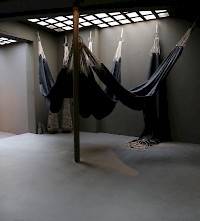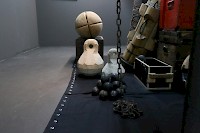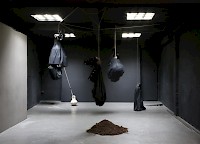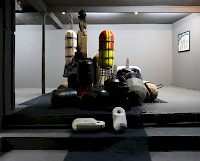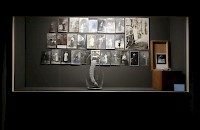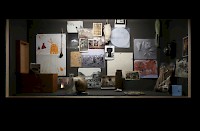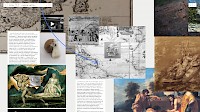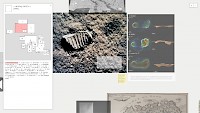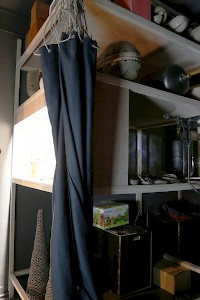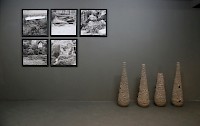SEALANDS
(11th Mar – 22nd May 2016: Vincent Chevillon, Semes at Espace Khiasma, Paris)
ARTICLES APPEARED IN Revista Arta, Nr. 24-25/ 2016
Labeled as instrument of power, machinery of imperialism, gear of colonialism, paraphernalia of patriarchalism misogyny and xenophobia, this storage and display space – the museum – is the object of stringent critique since the late 19th century. Museology and contemporary art have a long history of interactions span around reciprocal contestation, mimicry and assimilation: since modernism, art fluidly infiltrates into the institution to undermine its elitism, commercialism and monumentalism. Art's immediacy, dematerialisation and evanescence are played against the aspiration to immortality and self-perpetuation of the institution. It is in between these incompatible reading grids that the important issue of 'display' is being formulated. Display is essentially political and reading for example Bruce Altshuler (in his edited volume “Collecting the New”1) we know that by valuing ethnologic and museified objects not as individual, subjective artistic manifestations but as universally relevant items, the museum defines both their symbolic and material value, simply by acquiring them. In post-colonial discourse a fundamental point has been to overcome the gap between subjective and objective content production and to analyse the way in which historic material 'collected' from the African colonies was attempted to be 'objectified' according to universalist principles.2
Museologic and artistic work lead to different ways of perceiving an object. Seeing and seeing again a collection of objects, without intervening upon them, is the reading that a museum asks for, which determines a sedimentation of meaning and the conservation of objects and their significance.
In this light, the currently running show of Vincent Chevillon at Khiasma, Paris, Semes, curated by Olivier Marbeouf, (http://www.khiasma.net/exposition/semes/) functions as a subjective frame of information production. It can be read as a double hybrid: methodologically it fuses artistic and museologic classification and display, and conceptually it fabricates a new type of object, of an uncertain nature, form and functionality.
Vincent Chevillon has been developing SÈMES over the past three years in the form of an itinerant, ongoing project articulated around various geographic territories. The project was initiated on a sail-boat crossing the Atlantic Ocean and has shifted registers from personal, physical experiences of the artist, to virtual content and scientific questioning around maps, images, found and collected material.
The show brings together oscillating objects – melting historic and found items with self-made artistic pieces. They seem to reproduce the stereotype of 'ethnologic collectible' with the devices of contemporary art. The show also functions the other way around: the typical subjective knowledge production and single narrative of contemporary art is mimicry-ed by what by default passes to be perceived as an objective, trustworthy, historically acknowledged 'framing'/ presentation (the museologic display). The viewer himself stumbles between reiterating the prejudice of collective/indistinct authorship regarding these objects (since they are mostly presented in an undifferentiated display) and reinforcing an authoritative production of information: I exercise my authority of gaze by perceiving a personal object (old photography, relic, non valuable detritus) as part of an official, historic narrative, to which I associate it (without actually knowing it). The viewer is tempted to label them, in order to annihilate their ambiguity. By working with the hybrid nature of objecthood this show makes us perceive the object according to the ways in which information about this object is constructed and mediated.
The show is instituting as well a hybrid temporality by working on the level of convergences and divergencies between the museological and the artistic time-space. While entering the semi-obscurity of the Espace Khiasma, the viewer unconsciously searches for the present (as the time of the artistic act), while actually experiencing what is made to seem an atemporal dimension (the 'past-future' temporality of the museum), in which past collectibles are mummified for an undefined future.
The show of Vincent Chevillon, reloads the discussions around authorship and authoritative production of information in regard to museologic display methodology by opting for a changing display: during the exhibition time (11th March – 22nd May 2016) the exhibition changes four times. Repeatedly transporting from one environment into another the 'trophy', storing, taking out of the archive and temporary bringing the objects to display into a changing context seems 'enacting or playing museums'. The artist literally extracts from the first exhibition room (the darkened room of the collection-archive) objects which he assembles every time anew into the main bright exhibition space, infusing them with a new content, by association.
The exhibition can look like a functional 'cast' of a museum, a container of still open boxes with open questions around the subject.
The simple question arises: what is the critical and political potential of reproducing the format 'museum' into the format 'gallery'/temporary exhibition site? Is reiterating and mutating a structure a way to de-mask it?
The procedure is applied not only at the level of display, but also in regard to the objects, while many of them are finely crafted sculptures, playing the role of 'found objects', swinging identity between 'produced' and 'natural' item – another essential and ideologically charged distinction when it comes to ethnologic classification.
These crossed evocations of ideas, methodologies of content production and formal alphabets play also with the political potential of the idea of 'creolisation' and the 'mestizo'. We can think also of the writings of Donna Haraway and her idea of attraction between species that cannot metabolise each other totally and which generate the hybrid. These missed assimilations are present also in the objects of Chevillon, reinforcing the idea of inter-specific nature (here in between objecthood and natural species). The discursive program at Khiasma in the framework of the exhibition included also a talk by Fabrizio Terranova, where he talked about Donna Haraway's vision of the hybrid as a multiplicity, which functions by interdependency and co-evolution.
The political power of hybrids is to destabilise abusive categorisation and hierarchisation. In this sense we can also think about the virtual nature of every given object and in the context of this exhibition, these symbiotic objects without function, are rather conceptual objects that defy a classifying gaze.
In the interview between Olivier Marboeuf, the director of Espace Khiasma and Vincent Chevillon, published with the occasion of the exhibition, we read about this undefined space, the chaos and disorder of materials and ideas, which is assimilated by Olivier Marboeuf to the Atlantic – present in various works of Chevillon. The sea as space of circulation and exchange, filled with mixed narratives and projections, with a liminal and also tragic substrate of experience, is a mutable territory of hybridisation of forms. As space of creolisation, it is carrier of plural narratives, essentially opposed to the historical grand, singular narrative of the heroic 'conquestas' and explorations.
The idea of archive, is also present in this dialogue between Olivier Marboeuf and Vincent Chevillon - as an 'animistic space' where the objects are 'among each others'. This indistinctness of the content of the archive, assimilated in literature to the space of the unconscious, to which the subject himself has not full access, essentially functions on the same principle of generative hybridisation: it is the space of the potential, from which – by the implication of the factor of unexpectedness – the new can emerge through infinite possibilities of associations between its elements.
Boris Groys also talked in his essay On the New3 about the 'new' as directly emerging from its relation to the museum archive. The 'alive'/the new in art, which is considered to be outside the museum, the archive or the library is for him in reciprocal determination with the practice of collecting in museums. For its archive, the museum seeks the alive, the ‘real’ and co-produces it, in order to museify it.
Chevillon constructs by association also his online platform archipels.org. Here he groups sources (personal images, historic documents, his own works and exhibitions, video and sound material) into a virtual collage. The viewer can zoom in and out of loads and layers of materials, that spread and cross-connect in a rhizomatic structure into the deep void of the internet. Clicking randomly in the framework of one of the topics – SAUDADE – (Portuguese for longing), we access material about the island of Martinique, an insular region of France from the Antilles and the birthplace of Chevillon. We find assembled pages of literature books, a discourse of General de Gaulle, a musical piece on dissidence, a wrecked balena on the shore in an old photography, a page from a manuscript of 1740 entitled 'About the Imperfection of Women', an 'Ordonnance d'Etat' regarding the functionaries oversee in the colonial time, a lithography of Gericault, from 1818 depicting two boxers fighting (one black, one white) and much, much more.4
The site is a great work in web design and at the same time reveals its roots in Aby Warburg’s fascinating “Atlas of Mnemosyne”. Back in 1928, Warburg was constructing a database of images from all cultures and times, gathering around 1000 images (reproductions of all types), that he was pinning together on about 70 wooden plates. As Chevillon in Semes, Warburg was also switching the images on the boards, whereas every board was having a subject – the topics of research he was working on.5 Contrary to an illustrative and didactic use (images illustrating a certain topic), which characterized previous types of boards, Warburg turns the boards into a platform for association and content generation, incorporating the principle of Dada collage. The boards working together with his cultural analysis writings functioned as a 'Denkraum'/thinking space.6 He followed for example classical recurrent motives across art history up to modern social life in sports, politics etc.7 Warburg's method of research was further developed through the 'iconology' of Erwin Panofsky, an assistant of Warburg and cultural analyst, who put the basis of what is today called in the German academic realm 'Bildwissenschaft'. 'Iconology' follows the migration and transformation of certain motives in art history and the changing content with which they are invested, according to social and political shifting patterns.
Nevertheless Chevillon's virtual Archipels are not exactly a research platform. They work in a contrary way: whereas Warburg synthetised material, the website seems to spread or scatter information. Humour and some kind of cheeky joking are present. At the same time the site releases also the perturbing perception of the immensity of information and a sort of arbitrariness in meaning production. They can be maybe given meaning as diagrams of possible contaminations, or as web architectures of mutable densities.
Marta Jecu
All image credits: Vincent Chevillon and Khiasma
1 Bruce Altshuler (2007), Collecting the New, Princeton University Press.
2Regarding the historic contaminations between museology and modern and contemporary art, we can firstly think about Marcel Duchamp's String Installation in the exhibition of the First Papers of Surrealism, in New York, 1942. In 1969 Andy Warhol curated at the Rhode Island Museum a selection from the storage rooms of the museum, where he used and mixed different criteria of display: polaroids that he took of the objects, with the objects themselves as well as for example the storage containers without showing their content. In the 1980's Group Material show Timelines infuses the ordinary museologic periodisation with subversive content, mixing in an intertextual display works of art, artefacts and found documents. Approaching more recent examples, Fred Wilson, a contemporary Afro-American artist is a main reference in this field, contesting colonial patterns in today's museology. He is practising what can be called a artistic research work with museological objects.
